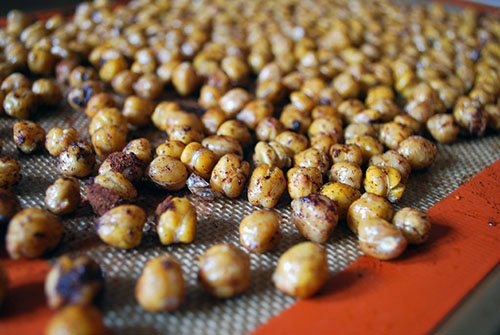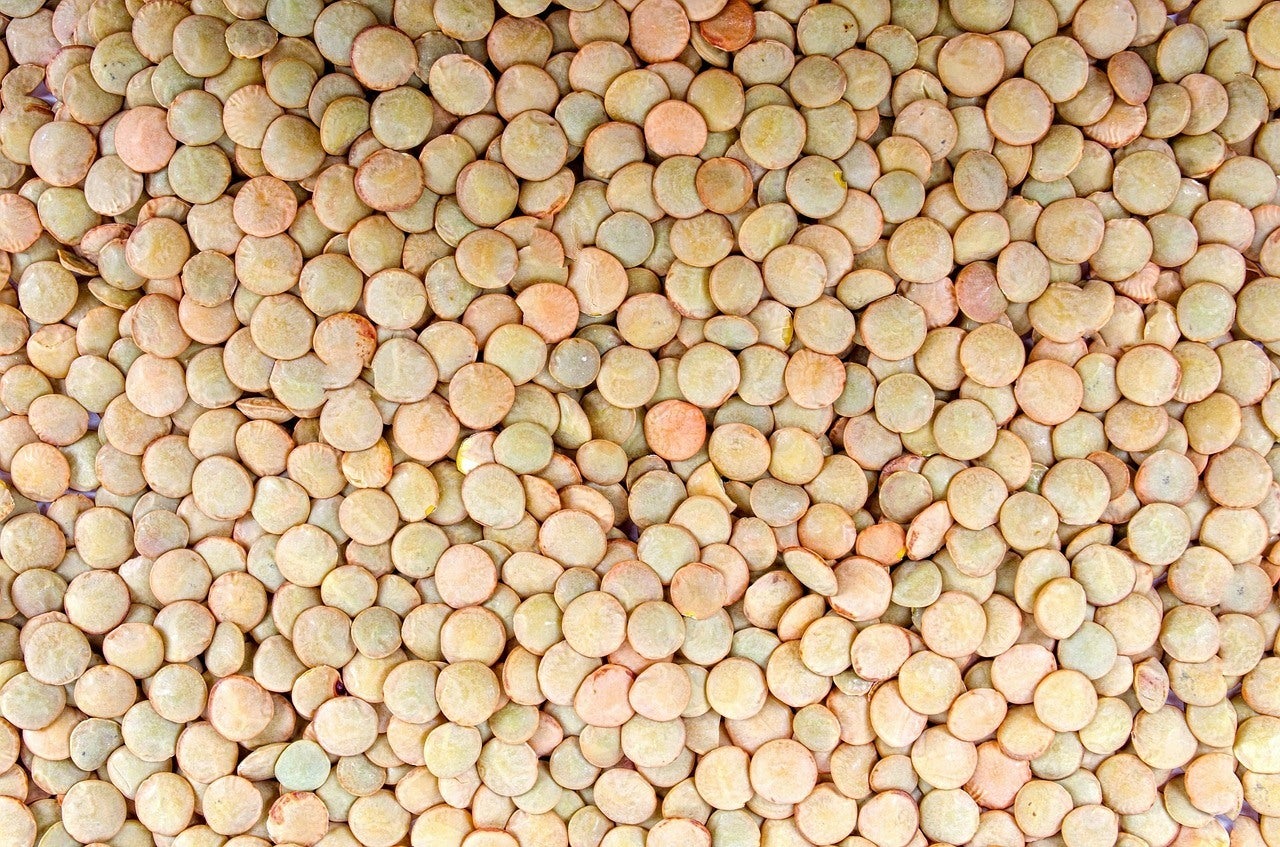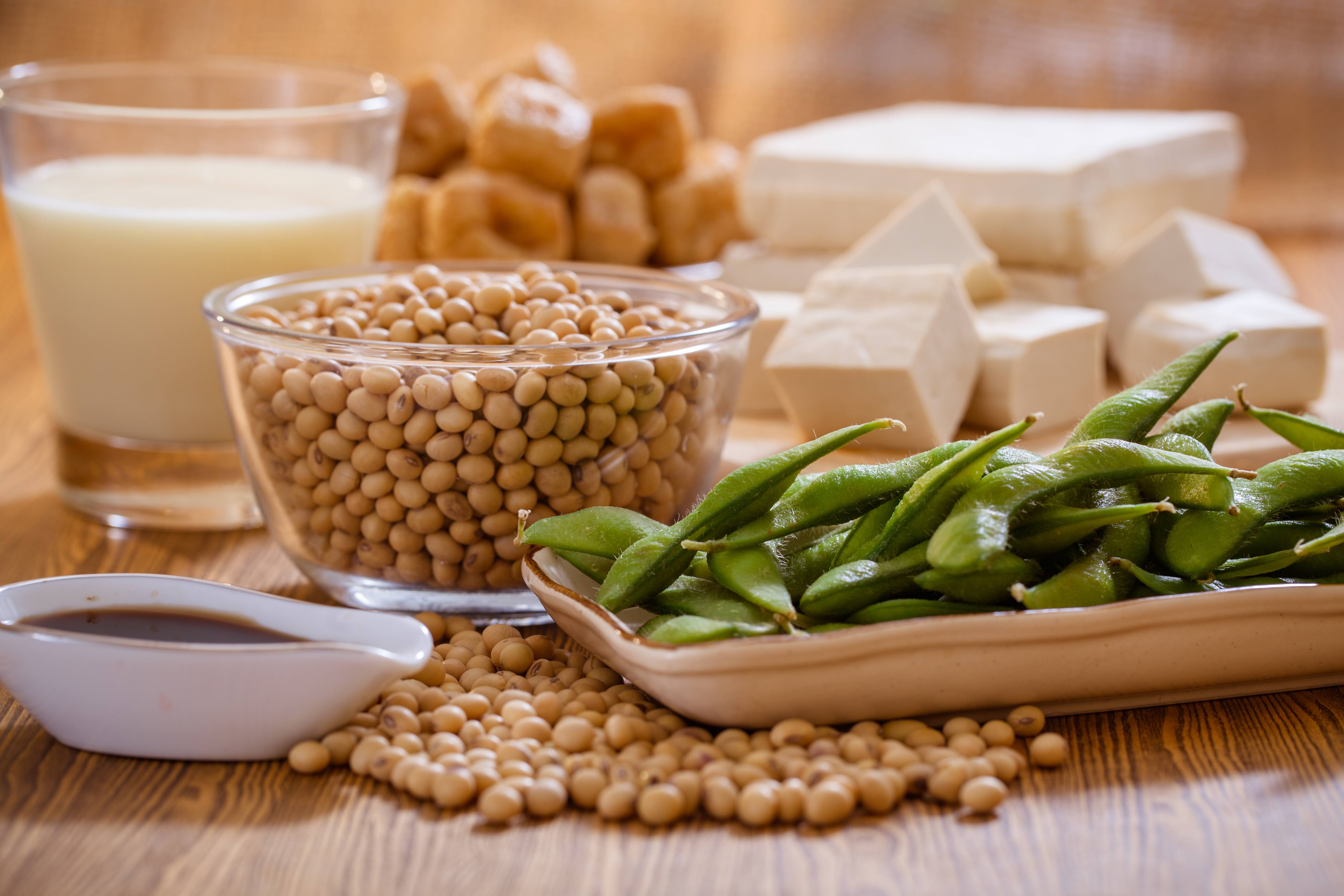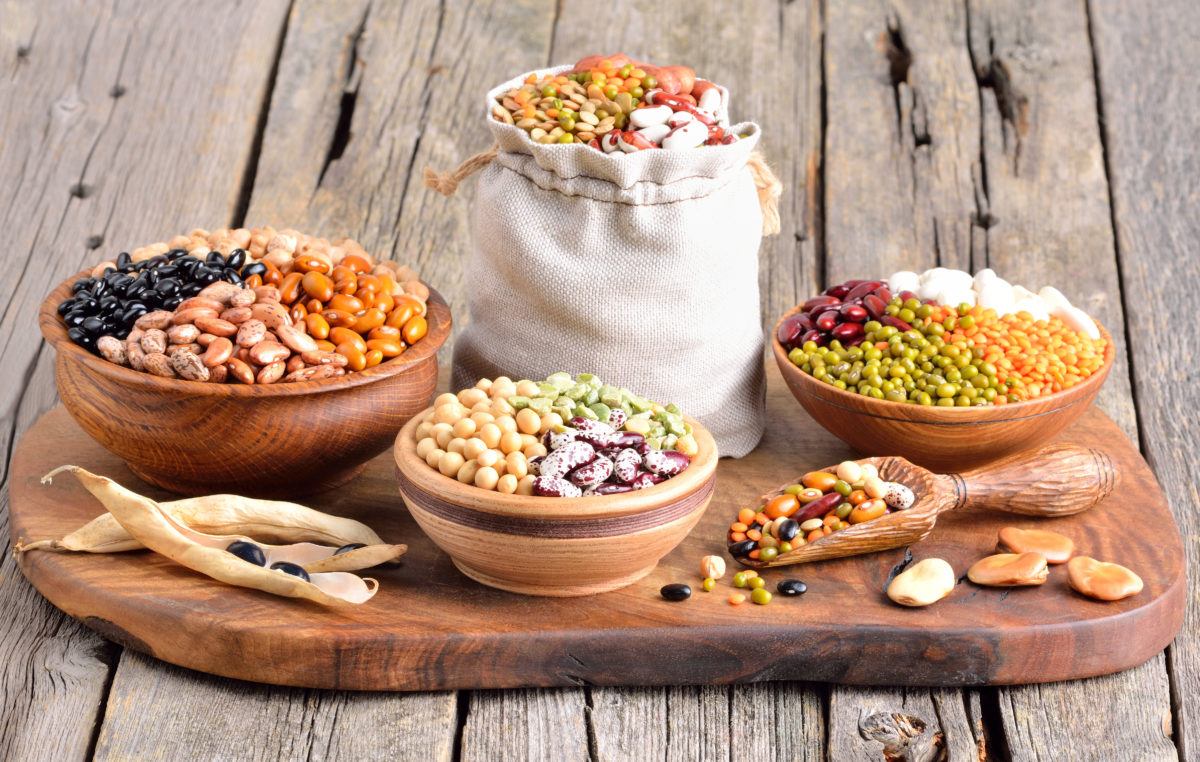The Fabaceae or Leguminosae (commonly known as the legume, pea, or bean) family is the third largest family of flowering plants, consisting of over 20,000 species. [1] Legumes are a nutritious staple of diets around the world. They are an inexpensive source of protein, vitamins, complex carbohydrates, and fiber.
Although used interchangeably, the terms “legumes,” “pulses,” and “beans” have distinct meanings. A legume refers to any plant from the Fabaceae family that would include its leaves, stems, and pods. A pulse is the edible seed from a legume plant. Pulses include beans, lentils, and peas. For example, a pea pod is a legume, but the pea inside the pod is the pulse. The entire legume plant is often used in agricultural applications (as cover crops or in livestock feed or fertilizers), while the seeds or pulses are what typically end up on our dinner plates. Beans in their various forms (kidney, black, pinto, navy, chickpeas, etc.) are just one type of pulse.
Legumes are emphasized by the U.S. Dietary Guidelines (about 3 cups a week) and the DASH Eating Plan of the National Heart, Lung, and Blood Institute (4-5 half-cup servings a week). [2] The Food and Agriculture Organization (FAO) of the United Nations declared the International Year of Pulses in 2016, focusing on the contribution of pulses in food production and nutritional diversity to help eradicate hunger and malnutrition. [3]
Source Of
Legumes and Health
Legumes contain several components that, when eaten as part of a balanced plant-rich diet, may help prevent the development of various chronic diseases:
Cardiovascular disease
There are several components of legumes that may benefit heart health including fiber, folate, and phytochemicals. Legumes in their whole unprocessed form are low in saturated fat and sodium. The fibers in legumes may especially help to lower blood cholesterol even without weight changes and may prevent sharp rises in blood sugar, both of which are risk factors for cardiovascular disease. [4]
- A meta-analysis of mostly observational studies found that eating legumes about 4 times weekly was associated with a 14% reduced risk of coronary artery disease. [4]
- Another meta-analysis of 11 clinical trials that looked at the effect of pulses on two types of cholesterol—HDL and LDL—found that intakes of pulses lowered fasting total cholesterol by about 7% and LDL (“bad”) cholesterol by 6%, whereas it raised HDL (“good”) cholesterol by 2.6%. The authors noted that soluble fiber, oligosaccharides (a type of carbohydrate), and phytochemicals in pulses likely contributed to this effect. [5]
- A cohort study looking at legumes and heart health followed 9,632 men and women free of cardiovascular disease at baseline from the National Health and Nutrition Examination Survey. It found that after 19 years, people who ate legumes 4 times or more a week had a 22% lower risk of heart disease and 11% lower risk of cardiovascular diseases (stroke, heart attack) than those who ate legumes less than once weekly.[6]
- A >meta-analysis of 36 randomized controlled trials involving 1,803 participants found that substituting plant-based proteins like legumes for red meat reduced risk factors for cardiovascular disease (blood cholesterol, triglycerides, blood pressure). [7]
Cancer
The fiber, phytochemical, and mineral content of legumes may have anti-cancer effects according to animal and cell studies. For example, nutrients in legumes such as zinc have been associated with improved immune function and decreased oxidative stress to cells, and selenium and phytic acid have been found to inhibit the growth of tumors in mice. However, there is less conclusive evidence from human studies on legumes and cancer protection.
Still, the World Cancer Research Fund (WCRF) and the American Institute for Cancer Research in their report, Food, Nutrition and Prevention of Cancer: A Global Perspective, included a public health goal of including pulses in most meals to help meet its recommendation of at least 30 grams of dietary fiber daily, as a high-fiber diet has been associated with a reduced risk of certain cancers like colorectal. [8] However, the WCRF specifically states that “foods containing dietary fibre decrease the risk of colorectal cancer” suggesting that there may be other components in high-fiber foods that could be affecting cancer development such as supporting the production of a short-chain fatty acid called butyrate (see “digestive health” section for further information).
Digestive health
Legumes contain fiber, resistant starches, and non-digestible carbohydrates like oligosaccharides. Resistant Starch, sometimes called slowly digestible starch, is not digested and enters the colon where it works similarly to fiber by promoting bulky stool and acting as a prebiotic food for beneficial bacteria like Bifidobacteria. [9] As these bacteria break down and ferment resistant starches and oligosaccharides, they create gas, which causes bloating and abdominal cramping in some people. Soaking dried beans for at least three hours and cooking them may help decrease this side effect. In the long run, however, these beneficial bacteria support normal bowel function and may reduce levels of cancer-causing compounds. [9] During fermentation, the bacteria also create a short-chain fatty acid called butyrate that may be associated with the prevention of colorectal cancer. [10]
Diabetes
Legumes have a low glycemic index, are high in fiber, and contain slow-digesting resistant starch—all of which may benefit in the prevention of diabetes. Despite these beneficial components, research results have been mixed and there is not yet a definitive answer that legumes help in the prevention of type 2 diabetes or the lowering of blood glucose. The limited number of small randomized controlled trials have not produced consistent results showing a benefit. Large cohort studies have also not been conclusive:
- A cohort study of 35,988 older women from the U.S. free of diabetes at baseline found that after 6 years of follow-up, no significant association with diabetes risk was found when comparing those who ate the most beans with those eating the least. [11]
- Another cohort study of 64,277 middle-aged women in China without diabetes at baseline found that after 4.5 years, those who ate the most legumes (about 1/3 cup daily) compared with the least had a 38% reduced risk of type 2 diabetes. [12] It is noted that this study specified legumes as including soybeans and peanuts along with pulses, whereas the prior U.S. study did not.
Obesity
Legumes contain dietary components that may help promote weight loss. Their protein and soluble/insoluble fiber content may increase feelings of fullness and modestly increase calorie expenditure through thermogenesis. [2] Only about 40% of fiber in a food is broken down during digestion, which reduces total calorie intake. [13] Fiber takes longer to chew, slowing down one’s eating pace, and slows digestion in the stomach, both of which may lead to feelings of fullness.
A study using data on 8,229 adults from the National Health and Nutrition Examination Survey found that people who ate beans had a lower body weight and smaller waist size than people who did not eat beans. [13] The bean eaters had a 23% and 22% lower risk of an increased waist size and obesity, respectively.
Because of their texture, flavor, and nutritional profile, legumes are found in numerous products throughout the supermarket. While these can include classic options such as tofu, peanut butter, and hummus, legumes and their components are also a key ingredient in a wide range of
plant-based meat alternatives. Because this product mix relies on varying degrees of processing, consumers should be on the lookout for added sodium, sugar, saturated fat from tropical oils, or other additives. The Nutrition Facts Label and ingredients list can be useful tools in deciding when to include a
processed food in the diet.
For Your Health and The Planet’s Health
 Food production places an enormous demand upon our natural resources, as agriculture is a major contributor to climate change, deforestation, species extinction, and freshwater depletion and contamination. However, along with varying impacts on human health, different foods also have differing impacts on the environment. Generally, the production of plant-based foods tends to have lower greenhouse gas emissions, and use less land and water than producing animal-based foods. In transitioning towards healthy diets from sustainable food systems—especially with our global population slated to reach 10 billion by 2050—legumes are slated to play a key role. The 2019 EAT-Lancet report that outlines a “planetary health diet” recommends 50 grams of legumes (about ¼ cup) in the daily diet. [14]
Food production places an enormous demand upon our natural resources, as agriculture is a major contributor to climate change, deforestation, species extinction, and freshwater depletion and contamination. However, along with varying impacts on human health, different foods also have differing impacts on the environment. Generally, the production of plant-based foods tends to have lower greenhouse gas emissions, and use less land and water than producing animal-based foods. In transitioning towards healthy diets from sustainable food systems—especially with our global population slated to reach 10 billion by 2050—legumes are slated to play a key role. The 2019 EAT-Lancet report that outlines a “planetary health diet” recommends 50 grams of legumes (about ¼ cup) in the daily diet. [14]
Legumes have a range of characteristics that make them a relatively sustainable crop. For example, legumes release up to seven times less greenhouse gas emissions per area compared to other crops, and can sequester carbon in soils. They can also make their own nitrogen from the atmosphere, thus reducing the application of nitrogen fertilizers. This leaves nitrogen-rich residues in the soil after harvesting; a benefit for the next crop planted in its place. [1] According to the FAO, drought-resistant species of legumes can be of particular benefit to dry environments where food security is often a challenge. They can also help minimize food waste, since pulses can be dried and stored for relatively long periods of time without losing their nutritional value. [15]
Bottom Line
Despite their wide variety, legumes share many common benefits. They are relatively sustainable and inexpensive, a low glycemic index food, rich in protein and fiber, and satiating. Because of their “meaty” texture, legumes can even stand in for animal-based protein foods in a variety of preparations. Additionally, their generally neutral flavor makes them versatile to blend well with other ingredients and pair easily with a variety of seasonings.
Learn more about some specific legumes, including a variety of ways to incorporate them into your meals:
Whichever name you call them, explore these versatile legumes; a staple of diets worldwide.
Lentils are one of the earliest domesticated crops, seen in the diets of ancient Rome and Egypt. Learn more about this staple legume.
Soy is a unique and widely studied food. Examine the research behind this nutrient-dense source of plant protein.
References
- Stagnari F, Maggio A, Galieni A, Pisante M. Multiple benefits of legumes for agriculture sustainability: an overview. Chemical and Biological Technologies in Agriculture. 2017 Dec;4(1):2.
- Rebello CJ, Greenway FL, Finley JW. A review of the nutritional value of legumes and their effects on obesity and its related co‐morbidities. Obesity Reviews. 2014 May;15(5):392-407.
- Considine MJ, Siddique KH, Foyer CH. Nature’s pulse power: legumes, food security and climate change. Journal of experimental botany. 2017 Apr 1;68(8):1815-8.
- Afshin A, Micha R, Khatibzadeh S, Mozaffarian D. Consumption of nuts and legumes and risk of incident ischemic heart disease, stroke, and diabetes: a systematic review and meta-analysis. The American journal of clinical nutrition. 2014 Jun 4;100(1):278-88.
- Anderson JW, Major AW. Pulses and lipaemia, short-and long-term effect: potential in the prevention of cardiovascular disease. British Journal of Nutrition. 2002 Dec;88(S3):263-71.
- Bazzano LA, He J, Ogden LG, Loria C, Vupputuri S, Myers L, Whelton PK. Legume consumption and risk of coronary heart disease in US men and women: NHANES I Epidemiologic Follow-up Study. Archives of Internal Medicine. 2001 Nov 26;161(21):2573-8.
- Guasch-Ferré M, Satija A, Blondin SA, Janiszewski M, Emlen E, O’Connor LE, Campbell WW, Hu FB, Willett WC, Stampfer MJ. Meta-analysis of randomized controlled trials of red meat consumption in comparison with various comparison diets on cardiovascular risk factors. Circulation. 2019 Apr 9;139(15):1828-4.
- World Cancer Research Fund. Diet, Nutrition, Physical Activity, and Cancer: A Global Perspective. A Summary of the Third Expert Report https://www.wcrf.org/sites/default/files/Summary-of-Third-Expert-Report-2018.pdf and https://www.wcrf.org/dietandcancer/exposures/wholegrains-veg-fruit. Accessed 8/2/2019.
- Singh B, Singh JP, Shevkani K, Singh N, Kaur A. Bioactive constituents in pulses and their health benefits. Journal of food science and technology. 2017 Mar 1;54(4):858-70.
- Canani RB, Di Costanzo M, Leone L, Pedata M, Meli R, Calignano A. Potential beneficial effects of butyrate in intestinal and extraintestinal diseases. World journal of gastroenterology: WJG. 2011 Mar 28;17(12):1519.
- Meyer KA, Kushi LH, Jacobs Jr DR, Slavin J, Sellers TA, Folsom AR. Carbohydrates, dietary fiber, and incident type 2 diabetes in older women. The American journal of clinical nutrition. 2000 Apr 1;71(4):921-30.
- Villegas R, Gao YT, Yang G, Li HL, Elasy TA, Zheng W, Shu XO. Legume and soy food intake and the incidence of type 2 diabetes in the Shanghai Women’s Health Study. The American journal of clinical nutrition. 2008 Jan 1;87(1):162-7.
- Papanikolaou Y, Fulgoni III VL. Bean consumption is associated with greater nutrient intake, reduced systolic blood pressure, lower body weight, and a smaller waist circumference in adults: results from the National Health and Nutrition Examination Survey 1999-2002. Journal of the American College of Nutrition. 2008 Oct 1;27(5):569-76.
- Willett W, Rockström J, Loken B, Springmann M, Lang T, Vermeulen S, Garnett T, Tilman D, DeClerck F, Wood A, Jonell M. Food in the Anthropocene: the EAT–Lancet Commission on healthy diets from sustainable food systems. The Lancet. 2019 Feb 2;393(10170):447-92.
- FAO. Pulses Contribute to Food Security. 2016. http://www.fao.org/resources/infographics/infographics-details/en/c/414726. Accessed 8/2/2019.
Terms of Use
The contents of this website are for educational purposes and are not intended to offer personal medical advice. You should seek the advice of your physician or other qualified health provider with any questions you may have regarding a medical condition. Never disregard professional medical advice or delay in seeking it because of something you have read on this website. The Nutrition Source does not recommend or endorse any products.

 Food production places an enormous demand upon our natural resources, as agriculture is a major contributor to climate change, deforestation, species extinction, and freshwater depletion and contamination. However, along with varying impacts on human health, different foods also have differing impacts on the environment. Generally, the production of plant-based foods tends to have lower greenhouse gas emissions, and use less land and water than producing animal-based foods. In transitioning towards healthy diets from sustainable food systems—especially with our global population slated to reach 10 billion by 2050—legumes are slated to play a key role. The 2019 EAT-Lancet report that outlines a “planetary health diet” recommends 50 grams of legumes (about ¼ cup) in the daily diet. [14]
Food production places an enormous demand upon our natural resources, as agriculture is a major contributor to climate change, deforestation, species extinction, and freshwater depletion and contamination. However, along with varying impacts on human health, different foods also have differing impacts on the environment. Generally, the production of plant-based foods tends to have lower greenhouse gas emissions, and use less land and water than producing animal-based foods. In transitioning towards healthy diets from sustainable food systems—especially with our global population slated to reach 10 billion by 2050—legumes are slated to play a key role. The 2019 EAT-Lancet report that outlines a “planetary health diet” recommends 50 grams of legumes (about ¼ cup) in the daily diet. [14]


